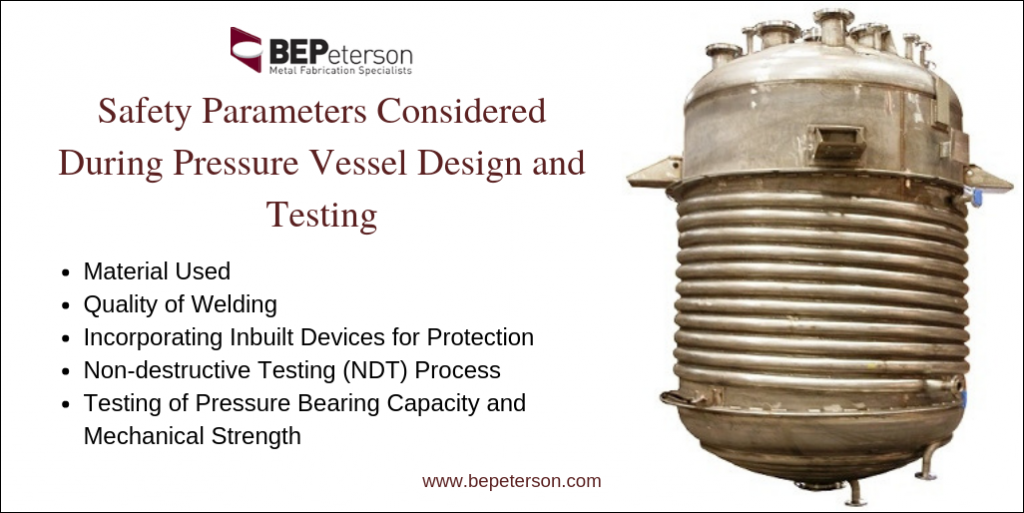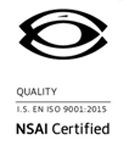Pressure vessels are closed tanks or containers designed to function at pressures higher than air pressure, usually 15psi, and hold gases or liquids inside at the required temperature. They have some inherent safety challenges due to the nature of their design and operation. This challenge increases, if volatile fluids or chemicals are stored in a vessel, as they may catch fire or explode at ambient pressures and temperatures. So, it is crucial that pressure vessel manufacturers incorporate safety features, including prevention of fire and explosion, when designing the vessel. This post focusses on pressure vessel design, inbuilt safety features, and standards set by The American Society of Mechanical Engineers (ASME) and ISO.

Safety Parameters Considered During Pressure Vessel Design and Testing
When designing, it is mandatory for pressure vessel manufacturers to stick to ASME vessel design guidelines for the safety of workers and the overall industrial unit. For end users of the vessels, it is important to ensure there are no cracks developed on the vessels after prolonged usage; this could lead to leakages and explosion. Hence, it is important to design a pressure vessel considering all the safety parameters:
- Material used: The material used for making a pressure boiler should be robust and not crack under pressure. Normally, they are made of carbon steel, nickel, stainless steel, 300 series & high temp SS, Inconel, aluminum, and more.
- Quality of welding: The quality of welding should be as per ASME standards mentioned in their section 8. Only welders who clear ASME P1-F3 are qualified to carry out the welding for such pressure vessels.
- Incorporating inbuilt devices for protection: This is a regular part of the pressure vessel design, which includes safety valves and vents in the design.
- Non-destructive testing (NDT) process: These non-destructive tests are carried out without disturbing the design. These include magnetic particle tests, ultrasonic, and radiographic tests.
- Testing of pressure bearing capacity and mechanical strength: It is crucial to test the mechanical strength of the pressure vessel and its pressure bearing capacity according to ASME standards.
Incorporating Fire and Explosion Safety Features in Pressure Vessels
Pressure vessels used across industries, and especially the ones designed to hold volatile liquids and chemicals, are equipped with a few safety features. This helps mitigate fire and explosion risks. Most of these features help the pressure vessel sustain a short fire without any damage. Here are some of the safety features:
- Steam gauges and valves: This is an inbuilt feature in the pressure vessel. Steam gauges help gauge the pressure of the steam within the vessel, whereas valves help release the pressure if it exceeds the preset limit.
- Fluid indicators: This is an inbuilt feature. This indicates the level of fluid in a vessel, thus preventing overflow and leaks.
- Pressure outlet valves: These are not internal like the steam valves but can be incorporated in the industrial facility to release excess pressure and avoid subsequent explosion.
- Fireproof insulation: This is an external feature, which helps reduce the spreading of fire and subsequent damage. The unit where pressure vessels are used has to be protected with fire insulation.
- Drainage vents: The industrial units where pressure vessels are used should have drainage vents.
- Water taps and sprinklers: This is a must in most industrial facilities as it mitigates the risk of fire in general. This may not be specific to only pressure vessels but can reduce the damage in case there is fire because of the pressure vessels or somewhere else in the premises.
- Emergency depressurization: This is an inbuilt feature in some pressure vessels used especially in industries such as oil & gas, chemical, and more, to mitigate the risk of fire and subsequent explosion.
Safety Standards and Certifications
There are certain application areas of pressure vessels wherein their capacity is tested to the core. These include petrochemical, oil refineries, nuclear reactors, submarines, spacecraft, and more. In these industries pressure vessels withstand harmful chemicals and gases such as LPG and ammonia. Considering such a high-pressure operating environment, bodies such ASME have laid down certain measures, which must be complied by pressure vessel manufacturers. Here are some measures by ASME:
- The measures which were laid down more than a century ago have undergone various amendments, with the latest ones in 2017.
- The section VIII for pressure vessels has three divisions.
- Division 1 provides requirements for design, fabrication, inspection, testing, and certification of pressure vessels operating at either internal or external pressures exceeding 15 psig.
- Division 2 has requirements on materials, design, and nondestructive examination.
- Division 3 has requirements catering to pressure vessels exposed to internal or external pressures more than 10,000 psi.
So, when buying pressure vessels for your industry, it is crucial to know the safety features incorporated in the pressure vessel during the design stage. Also, it is important to study the documents given out ISO and ASME standards and ensure that you buy from a reliable manufacturer who has ISO and ASME certifications. BEPeterson is one of the leading pressure vessels manufacturer and supplier in the US. We are ISO 9001:2015 certified and comply with the ASME vessel design guidelines.
VP of Business Development Dan Szczurko joins the podcast to discuss the pressure vessel business & market segmentation. Furthermore, he gives an overview of the sales process from a customer’s perspective.

